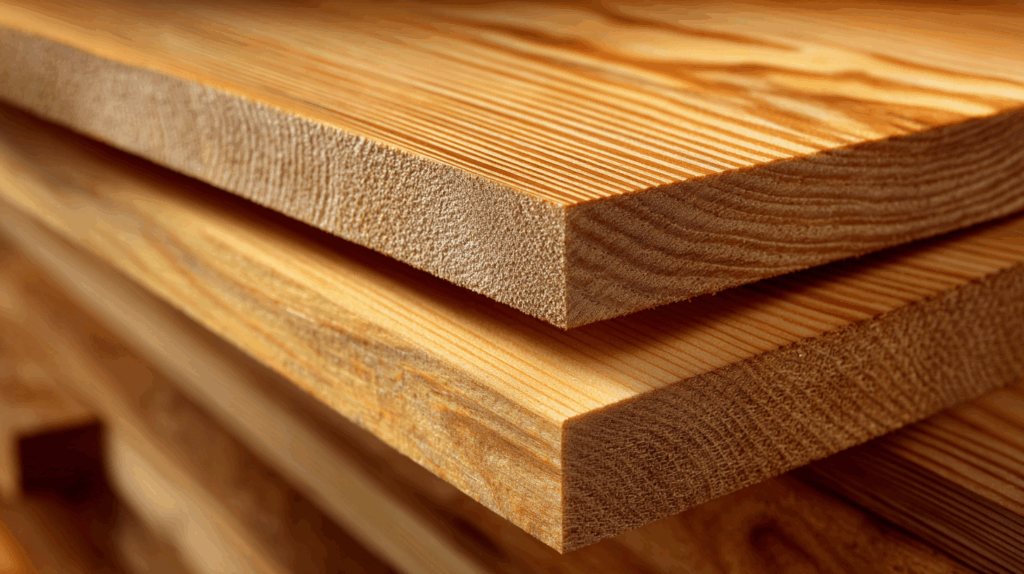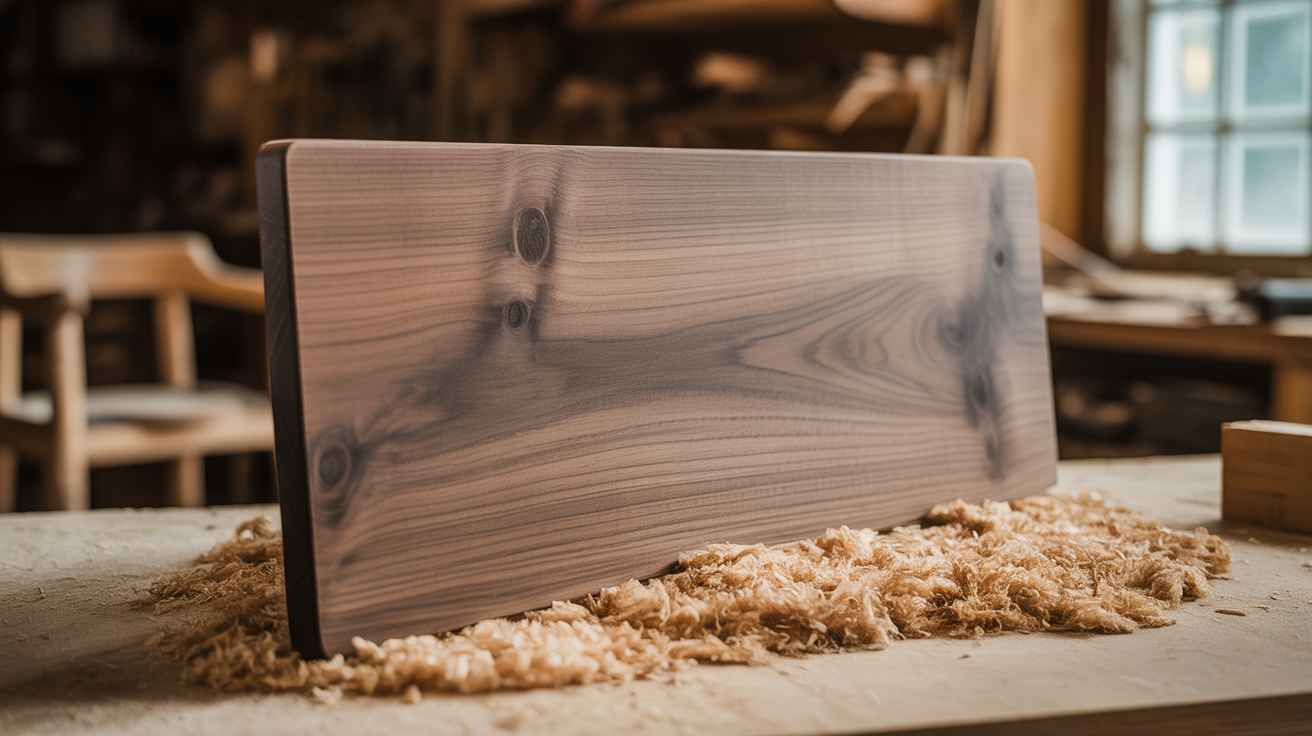When I first started fixing up my old kitchen, I had no clue what a furniture board was.
I just thought, “Hey, wood is wood, right?” Turns out, not quite.
The contractor mentioned it when we were looking at cabinet options, and that sent me down a rabbit hole.
If you’re like me, just trying to figure out if this stuff is worth using, you’re in the right spot.
In this guide, I’ll explain what furniture board is, where it shows up, and how it stacks up against other wood options like plywood and solid wood.
We’ll also look at the pros, the cons, and determine if it’s a good fit for your own project.
What Is Furniture Board?

Furniture board is a type of engineered wood. That means it’s not cut from a tree like regular lumber. Instead, it’s made by pressing together small bits of leftover wood (like chips, fibers, or flakes) using glue and heat.
Once it’s packed and flattened, it turns into a sturdy sheet.
There are two common kinds you’ll run into:
- Particleboard: Made from wood chips and sawdust. It’s the rougher, more basic version.
- MDF (Medium-Density Fiberboard): Made from super fine wood fibers. It’s denser, smoother, and often used for painted surfaces.
Compared to solid wood, furniture board is:
- Cheaper
- Smoother
- Weaker
If you’re working on something like a simple bookshelf, cabinet interior, or budget furniture, this stuff can do the trick without breaking the bank.
Just don’t expect it to hold up like real wood in wet or high-impact spots.
How Is Furniture Board Made?
Furniture board is made from leftover materials in the woodworking industry, such as sawdust, small wood chips, and shavings that would typically go to waste.
These scraps come from lumber mills and factories and are collected as the base material. This is how it all comes together:
1. Materials: The wood particles are mixed with a strong resin or glue that helps everything stick.
2. Pressed Together: This mixture is placed into large molds and compressed under high heat and pressure. That process bonds the materials into a dense, sturdy sheet.
3. Finishing Options: Once the board is formed, it gets a surface treatment depending on how it’ll be used:
- Laminate: A durable, plastic-like surface that comes in lots of colors and patterns, which is great for modern cabinets or shelves.
- Melamine: A thin, smooth resin coating that’s easy to wipe clean, often used in closets or office furniture.
- Wood Veneer: A thin slice of real wood glued to the surface. This gives the board a high-end, natural wood look at a lower cost.
The result is a flat, uniform panel that’s budget-friendly and easy to work with, perfect for furniture, built-ins, or kitchen cabinets.
Where Is Furniture Board Used?
You’ll spot furniture board in a lot of everyday items. It’s usually hidden under a surface like laminate, melamine, or paint, so you might not notice it right away. But it’s there, doing its job quietly behind the scenes.
Common uses include:
- Kitchen cabinets (especially the parts you don’t see, like the cabinet box or shelves)
- Bathroom vanities
- Bookshelves and built-in units
- Drawer bottoms and backs
- Budget dressers, desks, and nightstands
You’ll mostly find it in places where a flat, stable surface is needed and where keeping costs down is important. It’s not the star of the show, but it gets the job done when solid wood or plywood isn’t necessary.
Pros and Cons of Using Furniture Board
Furniture board may not be fancy, but it’s great for budget builds, rental units, and quick projects due to its advantages. However, it has some limitations to consider.
Pros: Why People Use It
- Affordable: Costs less than both solid wood and plywood
- Uniform Texture: No knots, warps, or funky grain patterns
- Finish-Friendly: Smooth surface holds laminate or veneer really well
- Lightweight: Easier to carry, cut, and install than heavier wood options
- Easy to Find: Available at most home improvement or furniture stores
- Good for Temporary Projects: Great pick for rentals, flips, or secondary spaces
Cons: Things to Watch Out For
- Moisture Issues: Swells, warps, or breaks down when exposed to water
- Lower Strength: Can sag or snap under heavy loads
- Short Lifespan: Doesn’t last as long as solid wood or high-quality plywood
- Edge Fragility: Chips easily when drilled, cut, or bumped
- Not for High-Wear Areas: Best kept out of bathrooms or heavy-use zones
The furniture board isn’t perfect, but it works when used in the right place. If budget matters more than longevity, it’s worth considering.
Furniture Board vs. Other Materials
Choosing the right material can be overwhelming, especially when everything looks like wood. However, understanding how furniture board compares to other materials can save you time, money, and headaches.
| Material | Cost | Strength | Water Resistance | Weight |
|---|---|---|---|---|
| Furniture Board | Low | Low to Medium | Poor | Light |
| MDF | Medium | Medium | Fair | Medium-Heavy |
| Plywood | Higher | Strong | Good | Medium |
| Solid Wood | Highest | Very Strong | Good | Heavy |
| Particle Board | Very Low | Low | Very Poor | Very Light |
No material is perfect for every project. For budget builds, furniture board works well, while plywood or solid wood offers better strength and durability. Choose based on cost, strength, finish, or longevity.
How to Identify Furniture Board?
Not sure if that cabinet or shelf is made from furniture board? It’s usually hiding under a pretty surface, but a few clues can help you spot it.
Look for these signs:
- Weight: Noticeably lighter than plywood or solid wood
- Edges: Often rough, crumbly, or flaky when unsealed
- Surface: Extremely smooth and consistent with no natural grain
- Covering: Usually wrapped in laminate, melamine, or a thin wood veneer
- Inside texture: When cut, the core looks like compressed cereal or particle mush
If it feels light, looks perfectly flat, and has a printed wood pattern on top, it’s probably furniture board. Tap on it too. You’ll hear more of a dull “thunk” than a solid “knock.”
Maintenance and Care Tips for Furniture Boards
The furniture board needs a little babying. It’s not as tough as solid wood, especially when it comes to water and heavy wear. But with a little care, you can keep it looking good for years.
- Wipe up spills fast: Don’t let water or liquids sit, or they can soak in and cause swelling
- Clean gently: Use a dry or slightly damp cloth; avoid soaking or spraying cleaners directly
- Avoid dragging: Don’t slide heavy items across the surface; lift and move instead
- Use protection: Coasters, placemats, and felt pads help prevent dents, scratches, and heat damage
- Mind the edges: Sealed edges help, but unprotected corners can chip easily. So, handle it with care
If you treat it gently, furniture board can last longer than you’d expect, even in high-use spots like cabinet interiors or side tables.
Final Thoughts: Should You Use Furniture Board?
So now you know the deal. What it is, how it works, and when it makes sense to use it.
If you’re trying to understand what a furniture board is and whether it’s suitable for your project, hopefully this has clarified things for you.
It’s not fancy. It just quietly does its job in the right setting.
I’ve used it in rentals, budget builds, and quick DIYs with no regrets. But I wouldn’t use it in my forever home kitchen or anywhere that might get damp.
At the end of the day, if you’re deciding between saving money or going for long-term quality, now you’ve got the info to make that call.
Use it where it makes sense. Avoid it where it doesn’t. Treat it right and it will hold up just fine.

